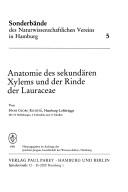| Listing 1 - 2 of 2 |
Sort by
|

ISBN: 3490135962 Year: 1981 Publisher: Hamburg und Berlin : Paul Parey,
Abstract | Keywords | Export | Availability | Bookmark
 Loading...
Loading...Choose an application
- Reference Manager
- EndNote
- RefWorks (Direct export to RefWorks)
Dicotyledonae --- Lauraceae --- wood anatomy --- Bark --- Wood --- Xylem --- Plant cells and tissues --- Vascular system of plants --- Plant anatomy --- Tree bark --- Woody plants --- Anatomy --- Classification --- Figure
Book
ISBN: 3030140563 3030140555 Year: 2019 Publisher: Cham : Springer International Publishing : Imprint: Springer,
Abstract | Keywords | Export | Availability | Bookmark
 Loading...
Loading...Choose an application
- Reference Manager
- EndNote
- RefWorks (Direct export to RefWorks)
This book presents the microscopic and macroscopic bark structure of more than 180 different tree and shrub species from Europe, Asia and North America. It is the first compendium to demonstrate the anatomical variability in bark since almost 70 years (Holdheide 1951). The introductory chapter explains with high-quality microphotographs the anatomical traits most important for identification and ecological interpretation of barks, and the monographic part demonstrates in text and pictures the species-specific patterns. The species treatments are grouped by their main biomes. Each species description first characterizes the macroscopic aspects with its main form, features and habitat with text and pictures of the whole plant and the barks in a young and old stage. This is followed by the microscopical description of each species. The microscopic photographs are based on double-stained slides, revealing the quality and distribution of unlignified and lignified tissues in low and high magnification. The book fills a scientific gap: Archeologists and soil scientists want to identify prehistoric and historical remnants. Ecophysiologists are interested in the distribution of conducting and non-conducting tissues in the phloem and xylem along the stem axis and the internal longevity of cells. Ecologists get information about internal defense mechanisms and technologists are enabled to recognize indicators relevant in biophysics and technology.
Bark. --- Tree bark --- Woody plants --- Anatomy --- Plant anatomy. --- Trees. --- Biodiversity. --- Microscopy. --- Wood. --- Plant Anatomy/Development. --- Tree Biology. --- Biological Microscopy. --- Wood Science & Technology. --- Plant Systematics/Taxonomy/Biogeography. --- Building materials --- Forest products --- Trees --- Timber --- Analysis, Microscopic --- Light microscopy --- Micrographic analysis --- Microscope and microscopy --- Microscopic analysis --- Optical microscopy --- Optics --- Biological diversification --- Biological diversity --- Biotic diversity --- Diversification, Biological --- Diversity, Biological --- Biology --- Biocomplexity --- Ecological heterogeneity --- Numbers of species --- Dendrology --- Nursery stock --- Arboriculture --- Forests and forestry --- Botany --- Plant structure --- Plants --- Structural botany --- Vegetable anatomy --- Structure --- Plant development. --- Forest products. --- Plant systematics. --- Plant taxonomy. --- Botanical classification --- Botanical systematics --- Botanical taxonomy --- Classification --- Plant biosystematics --- Plant classification --- Plant systematics --- Plant taxonomy --- Systematic botany --- Systematics (Botany) --- Taxonomy, Plant --- Plant taxonomists --- Development of plants --- Plant development --- Developmental biology --- Growth (Plants) --- Forest production --- Botany, Economic --- Commercial products --- Raw materials --- Ontogeny
| Listing 1 - 2 of 2 |
Sort by
|

 Search
Search Feedback
Feedback About UniCat
About UniCat  Help
Help News
News